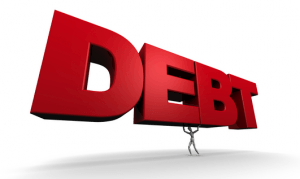Ghana’s public debt rises to GH¢200b in May as government adds GH¢46b more
 In 2015 when Ghana signed up to the three-year International Monetary Fund (IMF) Extended Credit Facility (ECF) for an amount of $918 million, the IMF classified the country as ‘high risk of debt distress.’ The country was so classified because of the level of its public debt. Four years later, in 2019, the country’s debt situation hasn’t improved, despite government’s touted ‘Ghana Beyond Aid’ mantra.
In 2015 when Ghana signed up to the three-year International Monetary Fund (IMF) Extended Credit Facility (ECF) for an amount of $918 million, the IMF classified the country as ‘high risk of debt distress.’ The country was so classified because of the level of its public debt. Four years later, in 2019, the country’s debt situation hasn’t improved, despite government’s touted ‘Ghana Beyond Aid’ mantra.
The country has also been cited as one of the 11 countries in Africa facing high risk of debt distress in the Economic Report on Africa 2019.
The Economic and Financial data released today by the Bank of Ghana puts Ghana’s total public debt at GH¢200 billion, which is 58.1 per cent of GDP, an increase of GH¢46 billion as at May 2019.
External debt is GH¢105.4 billion, at 30.6 per cent of GDP and domestic debt is GH¢94.6 billion, which is 27.4 per cent of GDP.
The public debt is however, expected to rise as the country enters an election year.
“Ghana’s public debt profile and associated servicing costs are expected to rise more so as it heads into the crucial 2020 elections cycle with rising public demand on the lack of improvement in living conditions,” economist, Dr. Theo Acheampong told ghanabusinessnews.com.
According to Dr. Acheampong, the current administration’s ambitious public-spending programme through the ‘One District, One Factory’ and Planting for Food and Jobs’ initiatives, and rolling out of free secondary education, known as Free SHS which is yet to be fully materialized.
“And given the declining domestic revenue mobilization effort, as well as the expected pressure of the elections, one can surmise that the debt levels are highly likely to further increase, possibly hitting 60 to 62 per cent of the new GDP or 75 per cent of the old GDP by end of 2020,” he added.
Dr. Acheampong pointed out further that a lot of these new debts are not necessarily going into financing critical infrastructure to catalyse economic growth but retiring old debts, some of which went into non-strategic white elephant projects.
“A large chunk of Ghana’s government revenues will be spent on servicing the country’s foreign exchange-denominated (mostly dollar: 67 per cent) debt. Total external debt service on central government debt amounted to $2.5 billion in 2018 alone (interest payment is 30 per cent of this amount). In contrast oil revenues from January to September 2018 amounted to $724 million. Just enough to service the interest payments on external debt!” he said.
By Emmanuel K. Dogbevi
Copyright ©2019 by Creative maginations Publicity
All rights reserved. This article or any portion thereof may not be reproduced or used in any manner whatsoever without the express written permission of the publisher except for the use of brief quotations in reviews.
